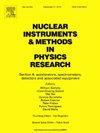Radiation resistance study of Gd-Al-B-Si-Ce3+ glass scintillators using 80 MeV proton beam irradiation
IF 1.4
3区 物理与天体物理
Q3 INSTRUMENTS & INSTRUMENTATION
Nuclear Instruments & Methods in Physics Research Section A-accelerators Spectrometers Detectors and Associated Equipment
Pub Date : 2025-07-29
DOI:10.1016/j.nima.2025.170869
引用次数: 0
Abstract
High-density Ce3+-doped Gd-Al-B-Si glass scintillators have been developed by the Glass Scintillator R&D Collaboration (GS Collaboration) for applications in nuclear and high energy physics. One of the critical factors in these applications is the radiation resistance of the glass scintillator. The impacts of proton irradiation on Ce3+-doped Gd-Al-B-Si glass samples have been investigated at doses up to approximately 4 × 104 Gy, utilizing the 80 MeV proton beam on the Associated Proton Beam Experiment Platform (APEP) located at the China Spallation Neutron Source (CSNS). The optical and scintillation properties, including emission, transmittance, light output, decay time and their degradation after proton irradiation, have been measured. Blue shifts of emission peaks were observed in X-rays excited luminescence (XEL) spectra after proton irradiation. Additionally, a red shift in the cut-off wavelength and a decrease of approximately 50% in transmittance at 400 nm were also observed after proton irradiation. The light output decreases by approximately 2/3 after 400 Gy proton irradiation, without significant alteration in the decay time constants of fast and slow components. This research serves as an important reference for evaluating the radiation resistance of high-density Gd-Al-B-Si-Ce3+ glass scintillators and can guide their practical applications.
80 MeV质子束辐照Gd-Al-B-Si-Ce3+玻璃闪烁体的耐辐射性能研究
高密度Ce3+掺杂的Gd-Al-B-Si玻璃闪烁体由玻璃闪烁体研发合作(GS协作)开发,用于核能和高能物理。在这些应用中的一个关键因素是玻璃闪烁体的抗辐射性。利用位于中国散裂中子源(CSNS)的联合质子束实验平台(APEP)上的80 MeV质子束,研究了约4 × 104 Gy剂量下质子辐照对Ce3+掺杂Gd-Al-B-Si玻璃样品的影响。测量了质子辐照后的发射、透过率、光输出、衰变时间及其降解等光学和闪烁特性。在质子辐照后的x射线激发发光光谱中观察到发射峰的蓝移。此外,在质子辐照后,还观察到截止波长的红移和400 nm处透射率的下降约50%。400 Gy质子辐照后,光输出减少约2/3,快、慢组分的衰变时间常数无明显变化。本研究为评价高密度Gd-Al-B-Si-Ce3+玻璃闪烁体的耐辐射性能提供了重要参考,对其实际应用具有指导意义。
本文章由计算机程序翻译,如有差异,请以英文原文为准。
求助全文
约1分钟内获得全文
求助全文
来源期刊
CiteScore
3.20
自引率
21.40%
发文量
787
审稿时长
1 months
期刊介绍:
Section A of Nuclear Instruments and Methods in Physics Research publishes papers on design, manufacturing and performance of scientific instruments with an emphasis on large scale facilities. This includes the development of particle accelerators, ion sources, beam transport systems and target arrangements as well as the use of secondary phenomena such as synchrotron radiation and free electron lasers. It also includes all types of instrumentation for the detection and spectrometry of radiations from high energy processes and nuclear decays, as well as instrumentation for experiments at nuclear reactors. Specialized electronics for nuclear and other types of spectrometry as well as computerization of measurements and control systems in this area also find their place in the A section.
Theoretical as well as experimental papers are accepted.

 求助内容:
求助内容: 应助结果提醒方式:
应助结果提醒方式:


